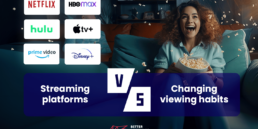Anyone remotely familiar with streaming platforms has probably heard the ubiquitous three-letter-acronyms OTT and VOD. Many people use these terms interchangeably when discussing various streaming technologies and platforms, but are they the same? What do they really mean? And, most importantly, are you using these terms correctly?
In this short article, we set the record straight and answer these nagging questions once and for all. This is your ultimate guide to understanding the difference between VOD and OTT.
Let’s start with the definitions.
VOD
Video on demand, or VOD for short, is a term used to reflect how people consume content today – they basically sit in front of the TV and pick the show they want to watch. Simple as that. There is no need to follow TV guides or listings and ask your neighbor to record Die Hard for you while you’re away on holiday. Instead, you just pick a Netflix show and watch it whenever you please – that’s how VOD works in a nutshell.
VOD is a broader category than OTT. VOD is always OTT, but OTT is not necessarily VOD because certain OTT platforms and hardware can be used to stream live events over the internet (like YouTube does).

The image above (courtesy of Wowza) nicely illustrates how VOD and OTT connect.
OTT
When you see the word OTT, it could mean many different things depending on who you ask. In this article, however, for the sake of brevity and clarity, we stick to the definition that OTT refers to any video streaming service delivering content to the users over the internet. In other words, OTT is about how it’s delivered to the audience (i.e. over the internet).
Originally, OTT services were offered by cable TV operators, hence existing ‘over the top’ of the cable service (rather than instead of it, as is more common today). When Sky announced a new agreement with Netflix to include Netflix’s subscription VOD offering into its pay-TV service, customers with its high-end Sky Q set-top box and service will be able to see Netflix titles alongside their regular Sky channels. Netflix was Sky’s OTT offering.
Such was also the case of HBO Go, which was offered only as a bonus for the HBO cable subscribers many years before it finally launched in many countries as an independent platform.
For more examples and a broader outlook on the OTT industry, read another in-depth article on our blog here.
What’s the difference between OTT and VOD?
To sum up, the difference is quite straightforward:
- OTT is about how the content is delivered.
- VOD is a broader category and is more about how the content is consumed.
Simple as that. However, it’s not surprising that at a certain level the discrimination is either impossible or… irrelevant.
Let’s now dig deeper and try to understand why these terms are so easily confused.
Why the VOD/OTT confusion?
We’ve identified a few reasons why people confuse the terms, use them interchangeably, or just don’t care about the difference.
1. It often doesn’t really matter
There, we’ve said it.
When discussed at some level of abstraction, it does not really matter if you’re referring to OTT or VOD. You’ll be fine using either term. For example, when you enter these terms in Google: “VOD content” (179,000 results) and “OTT content” (387,000 results) – both seem to work.
Although VOD is not always the same as OTT, the popular streaming platforms Hulu, HBO, Netflix and Disney+ can be easily classified as both. Case in point: here Netflix is referred to as VOD, and here it’s referred to as OTT. Tomato-tomato, it seems.
2. It depends on the specific use
Specific edge cases make the distinction confusing (albeit still unimportant). YouTube, for example, is always an OTT, but not always a VOD platform per se. When a live video is being streamed, it’s just OTT – and not VOD, because it’s not on demand as such.
3. Some markets never experienced true OTT
In many non-US regions (Poland included) cable operators never really offered bona fide OTT services. These markets mostly skipped the OTT phase and went directly from cable TV to using services like Netflix and Disney+. This explains why the distinction between OTT and VOD got so blurry. For them, it’s one and the same thing.
4. “Over the top” is quite a bad term
Just like the terms dial, ring, button, trailer, rewind and track, the term over the top is a bit of a confusing anachronism. It has sparked people’s imagination – what does it really mean? What is it on top of?
For example, it could be understood that you have to pay for the service (e.g. Netflix) on top of your ISP or cable provider subscription… The proper expansions should perhaps be “Over The Top of the set-top box” if it wasn’t such a mouthful.
Also, while OTT is commonly used to denote video content, many other services could use this definition just as well. Internet radios perfectly fit the OTT definition but are not necessarily VOD (as there is no video).
Long story short, it looks like the VOD vs OTT debate is far from resolution, but you be the judge.
Summary
We hope this quick article helped you understand the difference. If not – don’t sweat. In many cases, it doesn’t really matter that much. As long as VOD and OTT are considered, you can leave the nitty-gritty to the experts. At BSG we build OTT applications and VOD platforms – mobile applications, web and backend solutions for broadcasters, content owners, telecommunication and media companies.
Drop us a line and tell us about your project to see how we can help you build it.
If you find this article valuable, you can share it on social media →
Read more about the VOD & OTT Industry!
March 7, 2024
7 reasons why is sports streaming becoming so popular
Learn more about the reasons why sports streaming is becoming more and more popular right now.
February 29, 2024
Why should streaming platforms adapt to changing viewing habits?
Discover the strategies through which streaming platforms adjust to changing viewing habits.
February 20, 2024
What is Titan OS and what do we know about it so far?
Explore what distinguishes Titan OS, a new smart TV operating system. Discover its unique features before giving it a try yourself.
Are you looking for a partner to build a Video Solution?
Leave your email and a short description about your project. We would gladly discuss different cooperation possibilities!





